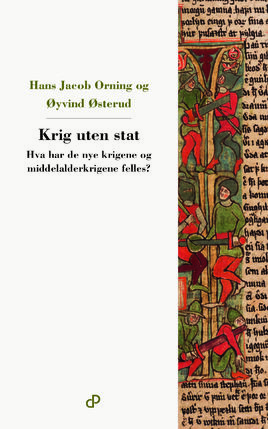Modern and medieval wars compared in new book

‘The modern conception of war is so entangled with the state that we have a hard time discussing war in societies where the state is absent, weak or failed’, says Professor of Medieval History Hans Jacob Orning, referring to inconclusive wars in, for instance, Afghanistan, Libya, Syria, and Southern Sudan.
Therefore, a comparison between these modern wars and those of the medieval times before states dominated can be fruitful, he and Professor of Political Science Øyvind Østerud argue in

The book is one of the products of the CAS project that Orning and Jón Viðar Sigurðsson led back in 2017/18: the Nordic 'Civil Wars' in the High Middle Ages in a Comparative Perspective. Østerud participated as a fellow.
- Read also: Research in Review: The Nordic 'Civil Wars' in the High Middle Ages in a Comparative Perspective
‘This book was started after our year at CAS, and is the first book-length product of our stay there’, Orning says, also revealing that the book will be translated into English.
Orning admits that the comparison at first hand might seem counterintuitive: rapid globalization, vast technological developments, the internet and a highly polarized ideological landscape are only some of what separate our modern world from that of the Middle Ages.
‘Beyond the obvious differences, we have found some similarities between how wars are fought in the modern and medieval times, which can be subsumed under the heading of our book’.
‘The “new wars” are actually very old’
Warfare in Western societies since the 17th century have been fought between state armies, mostly on the battlefield, and with clear divisions between war and peace, soldiers and civilians, as well as between soldiers and criminals.
‘However, in a larger historical perspective, this form of warfare is highly atypical, simply because the state is a historical aberration and newcomer if we expand our horizon’, Orning says. One can say Orning has had an expanded historical horizon for his whole career, as his main research field is the Nordic Middle Ages.
‘True, there were pitched battles and large-scale expeditions such as the crusades, all of which military historians have studied extensively. But normally, "war" was hardly distinguishable from "peace", because it was everywhere and nowhere.’
‘This was not a Hobbesian war of everyone against everyone’, Orning says. ‘Peace-making was just as important as war-making.’
It is these types of wars, so tightly enmeshed in the surrounding society that they can hardly be labelled "war", that Orning and Østerud argue have resurfaced in the last decades in the form of inconclusive wars fought in Afghanistan, Libya, and Syria, among other places.
The British political scientist Mary Kaldor called these wars “new wars”, in contrast to the "old wars" in Europe, such as the World Wars and the Napoleonic wars fought by states. She argues that the dichotomies between war and peace, soldiers and civilians, soldiers and criminals are blurred in the new wars.
‘We take her argument one step further and argue that the so-called "new wars" are in reality "very old wars" – similar to those fought in the Middle Ages.’
Orning and Østerud write about the various aspects of these structural similarities, such as the roles played by warlords, mercenaries and local populations.
‘And we discuss phenomena that are prevalent in this type of warfare, such as asymmetrical relations, the constant shifting of alliances, and the grey zone separating war from peace’, Orning says about the book.
The two University of Oslo-based professors started writing after the CAS year. Orning thinks that it is important for a project like one at CAS to be appreciated not only for its immediate output, but also for its long-term effects.
‘It is very rare to have the opportunity to concentrate so much on one project with a group of people as what CAS allows. For us, I think it would be safe to say that the fruits of CAS are materializing along two lines – the books we produced there, and the spinoffs that only now are starting to pop up.’
‘For instance, we have received a GRIEG grant, building on many of the ideas from CAS, and I am about to extend the comparative perspective from the CAS project into a new research project.’